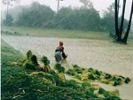Eye For Film >> Movies >> The Rice People (1994) Film Review
If life is uncertain, what do we hold onto? And if circumstances dictate that love will bring only pain, what can we look forward to?
Even when we know something is not quite true, it can give us comfort. Have you ever known anyone who kept a treasured teddy bear long past childhood? Holding on to ideas – we may do it for the warmth and sentiment they bring. Give a pet human characteristics. Try to fill a little gap somewhere that no human can fill. The religious among us might seek solace in a being for which there is no physical proof. A habit that is harmless yet perhaps not justified, other than by our fondness for it.

Cambodian people, officially Buddhist, have a generations-old tendency towards animism, investing everything – from a tree to a rock to a village - with guardian spirits or deities. Before we exclaim, “How backward!” let us remember that we celebrate Father Christmas, and many of us read horoscopes or avoid walking under ladders, even though we don’t ‘believe’ that the planets control our fate, or that bad luck in bucketfuls will fall on us from above.
It’s just the culture, the way of life. In Rithy Panh’s neo-realist film, The Rice People, we look at customs and a way of life that has existed for many years among rice farmers. At times lyrical, at times frightening, this is a story of sadness and beauty. Different strains of rice are given different poetic names. Folklore doctors are given due respect – and money; and western-style hospitals, the ‘sensible’ and even more expensive solution, tried if the more basic approaches don’t cut it. With ‘fingers crossed’ we hope western medicine will work – but of course, that sometimes can’t perform miracles either.
The story here is nominally based on the novel No Harvest But A Thorn by Shahnon Ahmed. It was previously adapted as a film by Jamil Sulong. Here, Panh says the backbone of the film is a woman he met in a refugee camp towards the end of the Cambodian civil war. She is Yim Om, a mother who loses everything: her family, her meagre sense of security, and even her sanity. Yet Om lives on. It is easy to read this as a symbol for the fate of Cambodia – rather like some other works by Panh such as, One Evening After The War, that probe the complex balance between accepting the crippling ravages of that country from outside, and attempting to survive. But the film’s beauty lies in its simplicity, in telling its story in a completely unadorned fashion.
Rice is not the easiest of crops. It needs a lot of attention – as we soon discover. Tending through different seasons, protecting from natural disasters such as flooding and storms – and fighting off predators such as sparrows and crab. Om’s village, like many in Cambodia even today, has no running water, no electricity, and not much access to medical care. They have enough rice paddies to eke out a living - and barely that. They know disaster can come from the usual quarters or, recalling the title of Ahmed’s book, something as simple as treading on a thorn. Put a foot out of action and the whole body can’t perform the needed heavy work at the critical time.
For Om and her husband Poeuv (and their seven daughters) they must carry on even when life seems unremittingly devoid of hope. “I’m like a floating weed carried off by the current,” declares Poeuv as one day he lies ill.
The Rice People reconnects us with a simpler way of living. A lifestyle that is hard, yet values the nobility of honest labour. We experience the simple joy of the rain. And for people whose lives depend on it, the joy is perhaps more sincere and heartfelt than that similar joy of young lovers in western movies, singing and frolicking in rain that is of little more significance than not having an umbrella.
When rice – or the weather – can mean the difference between life and death, not just for one’s immediate family but for one’s children and grand-children, is it not understandable that it begins to assume almost divine personas?
In some ways, The Rice People is a meditation on place, on nature. Comparable in some ways perhaps to Bela Tarr’s meditations on, and treatment of, buildings and structures: for instance, in The Man From London. Taken with the historical background of Cambodia, its endless struggles and frequent wars not of its own making, this paean to a simple food staple might be considered masterly. But how anthropological are we feeling today?
Panh explores colourful facets of village life. From unusual methods of traditional fishing, rituals of cremation, or the horrific (but eminently ‘reasonable’) methods of handling madness. It fills in many gaps for those curious about a culture and land which is practically unknown in the West. But the downside is that, unless water-logged Cambodian rural life really floats your boat, it may be consigned to that ‘worthy but forgettable’ shelf of South-East Asian cinema. Panh, who has seen the atrocities of the Khmer Rouge first hand (and with his film S21 triggered moves for implementing justice in that respect) seems almost an expression of the land that he loves rather than a director-artist ‘creating’ a movie himself. He is widely respected, from the Cannes Film Festival to Amnesty International, yet it is easy to see how his lesser films could leave some audiences unsatisfied. Rice People maybe makes the grade, but more by dint of the zero competition in the field of great directors from Cambodia than something that strikes a masterchord quite separate from its culture. We are, perhaps, being asked to love the rice fields rather more than the film.
Reviewed on: 07 Apr 2010




















